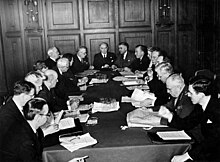Canada and the United Nations
At the signing of the Declaration by United Nations, Canada was one of four Dominions of the British Empire present, alongside Australia, New Zealand, and the Union of South Africa.
Canada is a member of Uniting for Consensus, a group that opposes the G4 nations' bids for permanent seats on the Security Council.
In 1957, then-Secretary of State for External Affairs Lester B. Pearson was awarded the Nobel Peace Prize for his role in the creation of the UNEF.
[2][failed verification] In 1947, Canada played an important role in the United Nations Special Committee on Palestine (UNSCOP).
Canada was one of the 33 countries that voted in favour of the 1947 UN partition resolution, which led to the establishment of the State of Israel despite heavy pressure from the United Kingdom on the Commonwealth of Nations Secretary of State for External Affairs Lester B. Pearson, having served as UN General Assembly President in 1952/53, proposed the concept of UN peacekeeping forces as a means of dealing with the Suez Crisis.
[10][11] Canada's successful role in mediating the 1956 Suez Canal Crisis gave it credibility and established it as a country fighting for the common good of all nations.
The 1945 film Now — The Peace, on the formation of the U.N. at the Dumbarton Oaks Conference, was produced by the NFB at the suggestion of Archibald MacLeish, then-Assistant Secretary of State for Public Affairs for the U.S.

